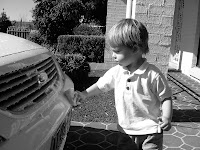
Three years ago I embarked on the quest to find a new watch.
It couldn't be all that hard, right? Dead wrong.
Up to that point I had been a faithful user of
Casio watches. I had a long-term thing for Casio - heck, they had made the calculator that nearly allowed me to scrape through my high school maths exams.
All my Casio watches had been digital, and extremely reliable. They'd been scratched to death, smacked on bricks and road surfaces, and one was even buried alive for four months before being exhumed - fully functional.
But when my last Casio expired in 2005, my heart turned away from digital and towards analogue; away from Tokyo and towards Geneva; away from sushi and towards cheese and banks.
As my interest in analogue watches grew, I remembered that my dad used to have one that required neither batteries nor manual winding. I thought that was uber-cool, and decided to find out what I could about a watch like this.
It didn't take too long to discover that this sort of self-winding watch is called, surprisingly, an
automatic. My dad bought his automatic in Switzerland in 1974 (along with a cardigan which appears in every family photo album since that time), but automatic watches had already been around a long time even by then.
Variations on the automatic have been in existence since 1770, with the modern rotor system emerging from the Rolex stable in 1931 in their
Oyster Perpetual.
Once I had discovered the world of automatics, there was no going back. But there was only one problem: price. Automatics were and are typically exxy. And none more so than Swiss autos.
It was then I discovered, to my great delight, that the Swatch watch company had manufactured a line of automatic watches powered by the Swiss-made
ETA 2842 movement. And the watch was enjoying some pretty darned good reviews -
this one kind of says it all.
I perused the Swatch range and settled on their 'Poisson Rouge' (French for 'gold fish') Irony automatic. Then it was off to eBay. $US33 later, I had myself a brand new Swiss automatic watch (plus $12 shipping).
After 29 years, I'd graduated from digital. I could finally cash in on those lessons we'd had in Year One involving a fake clock with "a big hand and a little hand" that the teacher manipulated around.
I've had this watch for three years now and still love it. From the rock-solid stainless steel case, to the sweeping second hand (a little red fish), to the solid blue leather band, it's a cool bit of gear. The back of the watch is also see-through, so you can swing the pendulum around, or just watch the constant smooth back-and-forthing of the balance.
I doubt I'll ever buy another battery-powered watch. This one doesn't keep perfect time, but it's got charm in spades. Any other automatic-watch-lovers out there?
 Today we spent a little time (and I do mean a little time – we have two small boys) wandering through the National Gallery of Australia.
Today we spent a little time (and I do mean a little time – we have two small boys) wandering through the National Gallery of Australia.






















